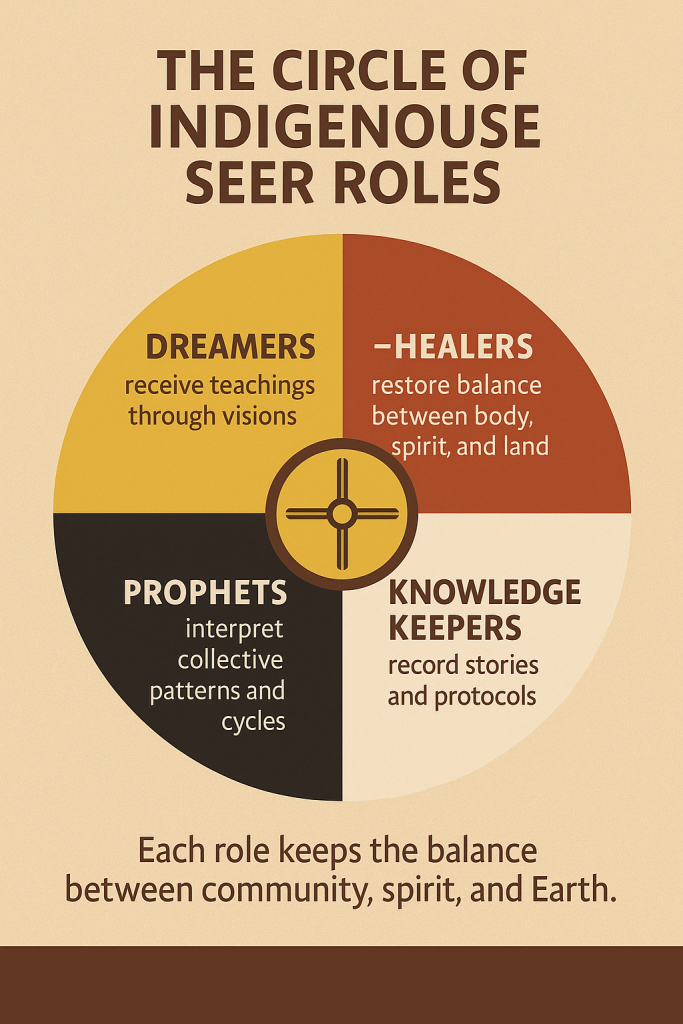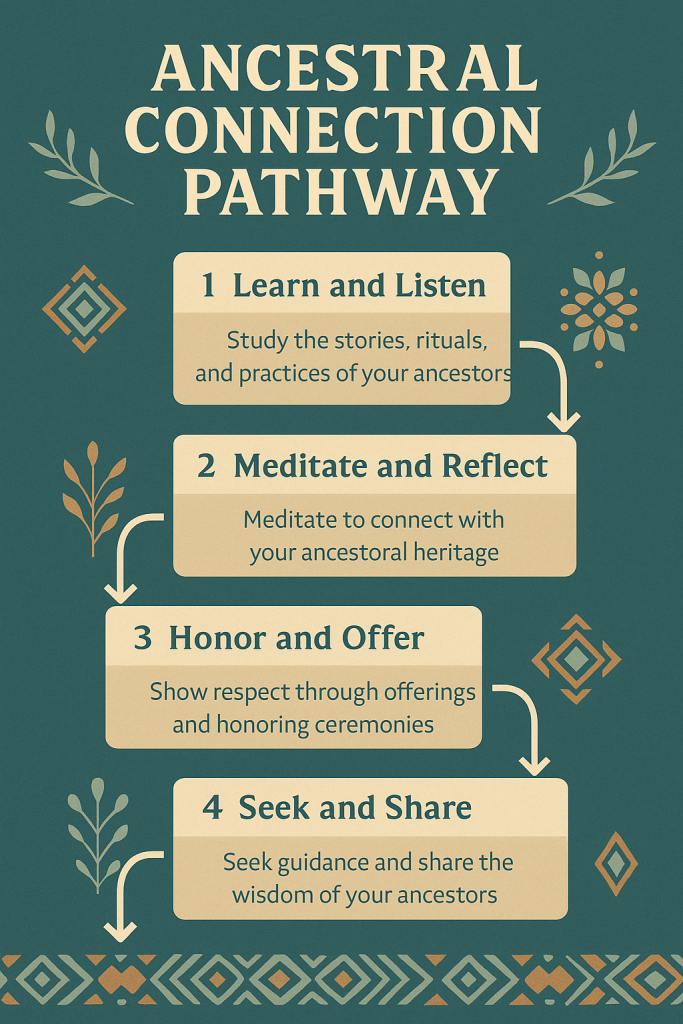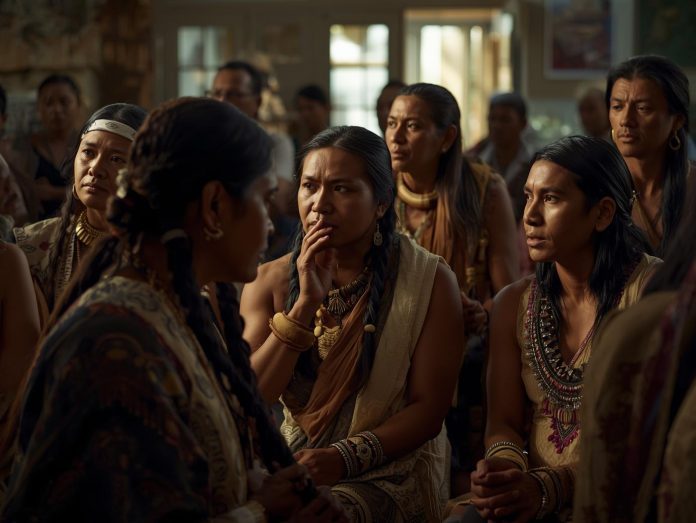Getting Ancient Wisdom in Today’s World
Think about sitting around a fire when an elderly person closes their eyes, starts to sway, and then begins to speak words that seem to be from ancient times but are very specific to things going on in your life. You might think of them as a psychic, healer, or even a visionary. In indigenous cultures, they call them seers. These are people who are able to see beyond the physical world to carry messages from ancestors, spiritual guides, and even the land.
Seers aren’t just past history, but they’re alive and they’re adapting to the world today. Even though our world is full of new changes in technology, data, and even algorithms, the indigenous Seers show us that there are other ways of knowing things that don’t fit on spreadsheets but carry real truths.
This article shows how Indigenous seers used their ancient wisdom to face modern challenges head-on. Keep reading to find out about their roles in different cultures, to see examples of what seers do, the threats they face, and why their voices matter. You will also see what spiritual seekers, psychics, and skeptics can learn from being resilient and listening.
What is the Role of Indigenous Seers?

Seer is a term that might make someone think that it’s a person who gazes into a crystal ball, but the truth is, this is just an indigenous tradition. A seer is someone who practices spirituality and a person who receives hidden truths from the spiritual world. Of course, depending on the culture, they might be called medicine people, prophets, shamans, psychics, or even oracles.
There are times when a Seer will go into an altered state of consciousness through chanting, fasting, drumming, or even with sacred plants. When they’re in these altered states, they get visions and guidance from ancestors or other spirits. They might get information about signs or about the weather, about illnesses, hunting, or even conflict. But they have central roles in healing, government, and decision-making.
The Cree Shaking Tent Ritual
According to Wikipedia, the Cree people of North America would do a shaking tent ceremony. This was a way that seers would communicate with the spirits. The seers would go to these tents that were built specifically for this ritual, and there would be movements and voices that would show that the spirits were there. People asked questions about the future, about things that were lost, and about concerns of the community. The spirits would answer through the seer. Outsiders thought that this was just entertainment, but those who participated in it saw that it was sacred communication between the people and the spiritual world.
Indigenous seers are more than people who just predict the future; they bring balance, harmony, and peace between the people and the spirits, and also the natural world around them. Their wisdom isn’t about being entertaining or making exciting prophecies but about guiding communities through times of uncertainty with peace and vision.
Seeing Indigenous Seers Working

Here are some real-life examples of Indigenous seers working:
Arvol Looking Horse – Lakota Spiritual Leader
A Lakota leader, Arvol Looking Horse, was known as the 19th Keeper of the Sacred White Buffalo Calf Pipe. He worked to protect the earth and shared his visions that warned people not to hurt nature. He talked about balance and taught people to trust and care for the land before it’s too late. He used words to connect old prophecies to the problems of today.
Hindou Oumarou Ibrahim – Blending Tradition and Climate Work
Hindou Oumarou Ibrahim is from Chad. She grew up learning to read the land, water, and weather. These skills were taught in her community for many generations. Today, she is also an activist who speaks at places like the United Nations. People trust her because she combines spiritual wisdom with modern climate work.
Vanuatu’s Wind Readers
On the islands of Vanuatu, there are seers called tupunus. They watch the sky, the winds, and the ocean waves to predict the weather. This helps guide fishing and farming. Even with climate change, these traditions are still very important. Elders are now teaching young people, so the knowledge will not be lost.
Aboriginal Star Watchers
In Australia, Indigenous elders have always read the stars. The constellations tell them when seasons will change, when animals will migrate, and how to keep their communities in harmony. Some of their stories match scientific events like eclipses or meteors. This shows that ancient wisdom can connect with modern science.
Why It Still Matters
These seers are not just part of history. Their visions and teachings are still alive today. They remind us that nature speaks, and if we listen, we can find balance and hope for the future.
Seers and Their Wisdom in the Modern Day
Indigenous seers are masters of preservation. Their knowledge systems have survived colonization, forced assimilation, and globalization not by accident, but through deliberate strategies of memory, practice, and adaptation.
Challenges that Indigenous Seers Face
Despite their resilience, Indigenous seers face immense pressures that threaten their practices. Many of these challenges are rooted in history, while others are emerging with modern life.
Keeping Seer Traditions Alive
Here are some great ways to keep traditions alive!
Oral Traditions and Learning by Watching
In many cultures, seers are taught through spoken stories. Elders share their wisdom by telling stories, singing songs, and showing rituals over and over again. Younger students watch, listen, and help with small tasks until the lessons become a natural part of who they are. This type of learning takes time and patience. A young person might spend years doing simple jobs, like carrying water for a healer, before they are trusted to learn how to enter a trance. This shows that humility and dedication are important parts of becoming a seer.
Sacred Tools and Special Places
Seers also use special tools, like drums, stones, feathers, or plants. These tools hold deep spiritual meaning. Certain places in nature, like caves, forests, or rivers, are seen as living libraries. Seers believe they can “read” the energy of the land in these spaces. Securing these places is important because they hold the stories, memories, and wisdom of the past.
Using Technology to Keep Traditions Alive
Today, some seers and their communities use technology to save their traditions. They record songs, stories, and rituals on video and only share them with people they trust. Families and groups who live far from their homelands use social media to stay connected and bring back old spiritual practices. This has helped many communities grow stronger instead of losing their traditions.
Working with Scientists and Schools
Some seers also work with researchers and schools, but this happens only when there is trust and respect. This makes sure the seer’s knowledge is treated as sacred and not something to take without permission. In Northern Canada, Cree elders worked with scientists to study ice conditions. The scientists measured thickness, while the elders used their senses to notice small changes, like how the ice sounded when it cracked or how the wind smelled. Together, they made better predictions than either group could have done alone.
Why It Matters
Through stories, rituals, modern tools, and teamwork, Indigenous seers are keeping their wisdom alive. These traditions continue to guide and protect communities today, showing that ancient knowledge can work hand in hand with the modern world.
Silencing the Seers
During the colonial times, colonial governments and missionaries tried to silence the seers from doing rituals and more. They would destroy sacred objects and punish the seers. Ceremonies like the Sundance or Shaking Tent became outlawed in North America. There are many indigenous children today who grew up hearing about the seer practices being evil or pagan, which was a stigma that was passed down during the colonization times.
Loss of Languages and Traditions
Language and Seer traditions work hand in hand. When a spiritual leader gives a word, it has a spiritual meaning, and by not keeping that meaning, it can lose its entire understanding. There are rituals that depend on songs, in prayers or even chants that cannot be translated into the French or English language without losing their power. As different languages disappear, so will the tools that Seers need to do their work.
Leaving the Land
There are many seer traditions that use the land to see their visions. They read about mountains, stars, winds, and rivers. Indigenous people who are forced to leave their ancestral lands lose access to their practices. Even climate change can cause disruption, such as rising rivers and seas, melting ice, and deforestation, which can loss the landscapes that have spiritual memory.
Sky Lore and Light Pollution
According to arXiv, cultures use stars as maps. Because of light pollution in modern day, it makes it challenging for people to look at the sky and to be led by the stars. According to Aboriginal sky traditions, they depend on seeing the constellations to gain understanding. With all the lights, it is hard for ancestral guides to have the opportunity to see the land the same way that the elders did.
Commercialization Over Sacredness
Another challenge that these people face is the challenge from interests outside of tradition. Elements of seer tradition, such as smudging, shamanic drumming, and dream catchers, are often replaced by wellness industries that don’t use cultural context correctly. This disrespects the sacredness of these practices and changes their meaning. For indigenous seers, it’s hard to see these rituals taken from the spiritual world and made into trends.
An elder of the Lakota talked about outsiders buying feathers from the gift shop. Instead of learning the teaching that each feather is a gift from the bird nation that came from a relationship, not to buy, it calls them to use commercialization instead of relevance.
There are real challenges when it comes to the Indigenous Seers to make sure that they protect their sacred lands, their sacred objects, and their rituals. These people survived for years and years, but their voices continue, even if they are more of a whisper.
Lessons that Modern Society Can Learn from Psychics and Spiritual Guides
Indigenous Seers aren’t just making sure that their community’s wisdom is saved, but they’re also trying to teach lessons that can inspire modern psychics and spiritual seekers all around the world. The practices that they did remind people that it’s easy to forget the truth because the world is fast-paced, but it can still be done.
New Ways that Seers Can Move Forward
The culture behind indigenous seers isn’t something that is left in the past. In our world today, they have blended different ancestral practices with modern tools to help make sure that their spiritual works stay alive and are useful for others. They are innovators who have taken on change and have adapted in creative ways, proving that ancient knowledge can still last in today’s day.
Online Rituals and Changes in Technology
With the changes in technology, there are seers who now will do ceremonies and rituals online or through video calls, especially when they’re not able to travel. Even though there are skeptics who might think that this is wrong, many clients feel the same energy and guidance as if they were in person, getting the same kind of reading. This proves that the idea behind the seers’ ship isn’t about geography, but it’s about intention, songs, and prayer.
Seers in Activists Roles
Seers have begun stepping into activist roles. They are making prophecies about environmental issues and are taking on ecological leadership roles. They talk to international people through conferences and remind the world that ancient teachings aren’t just about superstition, but they are about strategies that worked well in the past. According to the UNFCCC, these cultures show how the Indigenous worldviews helped to make the climate stronger and more resilient by linking ecological responsibilities with spiritual insights.
Seers Across Cultures
Seers can communicate with different nations because of modern communication. Māori Tohunga and Aboriginal Star Seers have started sharing their points of view. This has created a global network where people are able to keep their vision strong. This type of communication helps to bring tradition without taking away its uniqueness, and it creates a place of harmony and wisdom that goes across borders.
When Technology Sets the Stage
Technology has changed, and Sears is working with researchers and technologists to record things like oral histories, rituals, star lore, and more in ways that respect different cultures. A project in Australia used astronomical software to help map where Aboriginal star traditions were showing that they would be able to survive and be talked about for future generations, according to arXiv. AI is even being used to help support archives and store Indigenous knowledge that uses cultural protocols to make sure that it is protected and not exploited.
Elders in Vanuatu are teaching youth wind lore to add to their tablets so that they can record oral instructions. This shows that ancient voices and modern tools are working together to create living archives that have both intimacy and storytelling. The use of digital memory is changing for generations to come.
These changes show that the seers aren’t a thing of the past, but they have adapted as leaders. By using old and new traditions, this shows that their visions will survive and will become more relevant for future generations to come.
Trusting in Seers Today!
The world is full of technology, data, and forecasts, so it might not feel important to seek out indignant seers to get guidance. But when you take a moment to really listen, their voices can give you something that modern technology can’t. Their voices can bring meaning, connection, and foresight that’s rooted in culture, tradition, and relationship.
Seers Are More Than Predictors
Seers aren’t just predictors, but they’re moral people who share moral ideas. Even though technology can tell you information (such as how fast a glacier can melt), seers remind us how we should respond and why these things matter. The visions that they have aren’t as much about numbers as they are about responsibilities to the land, to the ancestors, and to generations yet to come.
Blending Seer Knowledge and Science
There are communities all around the world that are taking SEER knowledge and blending it with science to be able to have more insights. People who research climate know that there are indigenous forecasting systems like sky reading, wind lore, and animal behavior observation that give critical early warnings that data can’t. According to UNDP Climate Promise, studies show that Indigenous worldviews not only make the culture stronger, but they also help people to face global challenges in the present.
Sharing Similar Messages Across Cultures
There are many cultures that have been seen sharing similar messages. If humans don’t honor nature, then there will be an imbalance. There are Lakota prophecies about how the environment will fail, and Murray warnings about polluted rivers. The consistency of these visions and messages shows that this is more than just a coincidence. It is as if the earth is telling you through the mouths of different cultures, hoping that someone will listen and bring change.
Healing on a Personal Level
Seers offer healing in the modern day and on a personal level. If a person is grieving, getting a dream interpretation might help them. Someone who has just fallen ill might need a ritual to restore their balance. Visions that give hope to travelers can be life-changing experiences. They show that prophecies aren’t just linear, but they’re practical and real.
In Chad, Hindou Oumarou Ibrahim used different ancestral seer knowledge and a climate advocate to help communities to plan how to survive a drought. The villagers had trust in her because she was using the ancestral language and science. This wasn’t just a symbolic role for these people, but it was lifesaving for them.
When we trust indignant seers, it’s not about refusing to be modern, but it’s about expanding the sources of wisdom that are at our fingertips. If psychics and seekers use intuition and believe that the spiritual world is real, then we can look at indignant seers as living proof. They have taken knowledge that has been preserved for many years and used it as power today.
Final Thoughts: Living Bridges Between the Physical and Spiritual World
Indigenous seers are living bridges between the physical and spiritual worlds. They take wisdom from the past and help it to make our uncertain futures feel better. They aren’t just things that you’ll find in a museum or voices that are fading, but they’re resilient, full of life, and relevant to our lives today.
Through dreams, symbols, songs, prayers, and rituals, they take ancient knowledge in ancient ways and add innovative digital archives, online ceremonies, and global activism to put them together to give us our best lives.
The visions that they have can remind us that modern noise can drown out ancient voices. But we have to remember that the earth is alive, the ancestors still talk, and each human has the intuition that they need to honor these things from the past. For those who are psychics and spiritual leaders, Indigenous seers aren’t just role models, but they prove that foresight and spiritual knowledge can last for years when it’s rooted in service, humility, and connection.
Humans want direction and healing, and seers can give these people what algorithms can’t. They can take their wisdom and share it from their heart, inviting you to slow down, listen to what the land is saying, respect the ancestors, and think of a future where predictions are nurtured. Believing in psychics and seers isn’t acting on blind faith, but it’s aligning a timeless practice with modern days that can help guide people when they’re not certain about their lives.
FAQ: Indigenous Seers
1. Who are Indigenous seers?
They are vision keepers, dreamers, medicine people, elders, and knowledge holders entrusted by their communities to relay guidance from spirit, ancestors, and land.
2. How do Indigenous seers differ from mainstream psychics?
Their work is lineage-based and community-centered, often embedded in ceremony, language, and land stewardship, with ethics shaped by collective wellbeing rather than individual branding.
3. What roles do land and ancestors play in their practice?
Land is a living teacher and archive; ancestors are active relatives who offer instruction, caution, and protection through dreams, ritual, and signs.
4. Is it appropriate for non-Indigenous people to seek guidance from Indigenous seers?
Yes—when invited and approached with humility, consent, and respect for protocols, fees, and boundaries defined by the community and practitioner.
5. What are common protocols I should know before a session?
Ask about consent, offerings, photography rules, confidentiality, and whether certain questions are culturally restricted; follow the seer’s instructions exactly.
6. How do Indigenous seers preserve wisdom in modern settings?
Through language revitalization, apprenticeships, ceremony, land rematriation work, digital archives controlled by communities, and youth mentorship.
7. What is cultural appropriation in this context?
Using ceremonies, regalia, songs, symbols, or titles without permission or training, profiting from them, or presenting them outside proper protocol and community oversight.
8. How can I discern respectful collaboration versus exploitation?
Look for community leadership, clear consent, transparent benefit-sharing, accurate attribution, protection of sacred knowledge, and the right to say no.
9. Do Indigenous seers predict the future?
Most emphasize responsibility over prediction—reading patterns, teachings, and signs to support right relationship, not certainty or spectacle.
10. How are seers accountable to their communities?
Through elders’ councils, clan systems, ceremonial obligations, and reciprocal service; authority is earned across years, not self-declared.
11. Can technology help protect ancestral knowledge?
Yes, when communities control access and context—e.g., passworded archives, cultural-use licenses, and data sovereignty standards.
12. What are practical ways to support Indigenous wisdom keepers?
Hire them ethically, credit their teachings, follow protocols, donate to land/language initiatives, purchase from verified artisans, and amplify their leadership.





“This made me cry a little 😢 The part about feathers being gifts and not for sale hit deep. We should respect these practices more instead of turning them into Instagram trends.”
I think this article is really cool! 🧙🏾♂️ It’s like magic people are still around, and they help others with their powers. I didn’t know they used stars and stuff to help farms! That’s awesome!
So let me get this straight… ancient people knew how to read the wind, stars, and spirits better than we can read a weather app? I don’t know whether to be impressed or concerned about where humanity peaked. 🌪️✨
*Oh sure*, now we’re doing Zoom séances? Next thing you know your grandma’s ghost will be sending you calendar invites from beyond the veil 😂 Technology really said ‘new age but make it WiFi.’
What bothers me most is how sacred rituals are being turned into commercial products. You walk into a store and see dreamcatchers next to scented candles labeled ‘tribal essence.’ It’s disrespectful and distorts the original meaning entirely.
Reading this was like listening to an ancient song that you somehow already know the words to. There’s rhythm in their rituals—chanting, drumming—it all ties into something bigger than ourselves. Their wisdom really grooves with nature’s beat 🎶🌿.
This is just another way to romanticize outdated beliefs. While it’s nice to honor tradition, relying on seers in a world of science is just irresponsible. Vision and prayer can’t stop climate change—action can.
As someone who’s spent decades studying cultural anthropology, I must say the preservation of oral tradition through modern tech is fascinating. Using AI respectfully for archival purposes shows how adaptive these communities are—resilience wrapped in innovation.